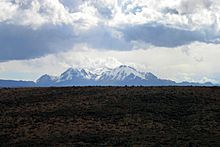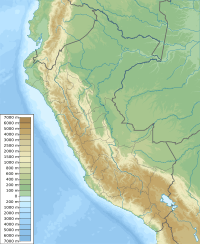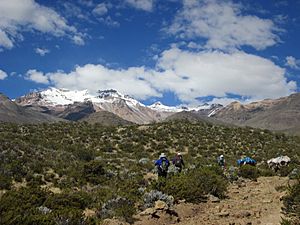Hualca Hualca facts for kids
Quick facts for kids Hualca Hualca |
|
|---|---|
 |
|
| Highest point | |
| Elevation | 6,025 m (19,767 ft) |
| Prominence | 692 m (2,270 ft) |
| Parent peak | Ampato |
| Geography | |
| Location | Arequipa, Peru |
| Parent range | Andes, Peruvian Andes |
| Geology | |
| Mountain type | Stratovolcano |
| Volcanic arc/belt | Central Volcanic Zone |
| Last eruption | Unknown |
| Climbing | |
| First ascent | 6 April 1966 - Richard R. Culbert (Canada) |
Hualca Hualca is a tall, extinct volcano in the Andes mountains of Peru. Its name might come from the Aymara or Quechua word wallqa, meaning "collar." This impressive mountain stands at a height of 6,025 meters (about 19,767 feet). You can find it in the Arequipa Region, specifically in the Caylloma Province of Peru.
Contents
Geography and how it formed
Hualca Hualca is part of a group of volcanoes called the Central Volcanic Zone of the Andes. This zone formed because the Nazca Plate (a huge piece of the Earth's crust) is slowly sliding underneath the South American Plate. This movement causes melted rock (magma) to rise, creating volcanoes.
Other volcanoes in Peru that are part of this zone include Ampato, Chachani, Coropuna, El Misti, Sabancaya, and Ubinas.
Hualca Hualca is linked to two volcanoes located to its south: Sabancaya and Ampato. Hualca Hualca is older and more worn down than these two. All three volcanoes grew on top of older volcanic rock layers. Over time, Hualca Hualca erupted thick flows of lava. The rocks from Hualca Hualca contain different types of crystals, which tell scientists about how the magma formed deep inside the Earth.
When a part of the volcano collapsed
A very long time ago, between 1.36 and 0.61 million years ago, the northern side of Hualca Hualca had a huge collapse. Imagine a giant chunk of the mountain sliding down! This event created a large, bowl-shaped area and formed a lake in the nearby Colca Valley. Eventually, this lake broke open, causing a huge flood.
Later eruptions within this collapsed area created new lava flows. These flows sometimes acted like natural dams in the Colca Valley. Smaller lava domes and hot ash flows also came from this collapsed section. Scientists believe that earthquakes and changes in the rock caused by hot water probably led to this big collapse.
Ice and water on the mountain
During the last glacial period (also known as the last ice age), which ended about 11,500 years ago, Hualca Hualca was covered in glaciers. These glaciers left behind signs like piles of rock and dirt called moraines.
Since the ice age, the glaciers on Hualca Hualca have shrunk a lot. One glacier was even reported to have disappeared by the year 2000. The melting snow and ice from Hualca Hualca are very important. They provide water for the Colca Canyon below, which helps farmers grow crops. Local people have long respected and worshipped the mountain. In 1586, some reports said they believed their ancestors came from Hualca Hualca.
Recent activity
Even though Hualca Hualca is considered an extinct volcano, some parts of its southwestern side show signs of activity from the last 11,700 years. In the early 2000s, satellite images showed that Hualca Hualca was actually "inflating" or swelling up. This swelling happened about 13 to 11 kilometers (8 to 7 miles) deep, at a rate of about 2 centimeters (0.8 inches) per year.
This swelling might be connected to the nearby volcano, Sabancaya, which is currently active. Sometimes, the underground areas where magma collects (magma chambers) can be far from the volcano itself. The swelling of Hualca Hualca stopped after 1997.
In an area called Pinchollo, within the old collapse scar, there used to be three geysers (hot springs that shoot water into the air). As of 2013, one of them, named Infiernillo, was still active. Since 2016, the activity of the hot water systems at Hualca Hualca has increased. This increase is linked to eruptions from Sabancaya and local earthquakes.
Climbing the mountain
It's possible to climb Hualca Hualca from the village of Pinchollo, starting from the north side. The first person known to reach the summit was Richard R. Culbert from Canada, on April 6, 1966.
However, there is also evidence that people climbed Hualca Hualca long before that. Near the top, climbers have found things like coca leaves and a puma skin. These items suggest that the Inca people, or other groups from before Christopher Columbus arrived, might have climbed the mountain too. Some reports mention Piero Ghiglione and P. Chavez reaching a secondary summit on August 23, 1950.
See also
 In Spanish: Hualca Hualca para niños
In Spanish: Hualca Hualca para niños
- List of mountains in the Andes
- Lake Mucurca



